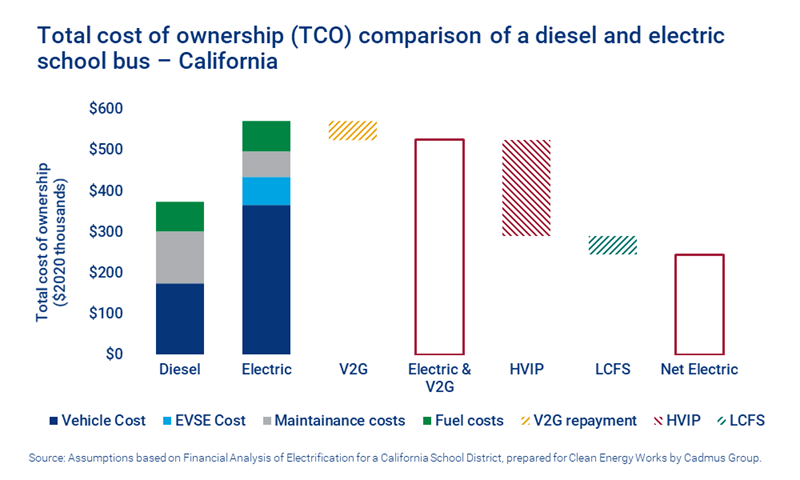What ‘vehicle-to-everything’ electric vehicle pilots mean for the grid
Lessons learned from six electric bus V2X pilots
1 minute read
As rates of bus electrification continue to rise globally, fleet operators are looking to a novel solution to drive down costs and smooth the transition: vehicle-to-everything (V2X). So, what’s the potential of this technology, and what stands in the way of commercialisation?
In a new report, Wood Mackenzie partnered with the Columbia School of International and Public Affairs to explore six recent V2X pilots in the US and UK. Lessons Learned from V2X Projects of Electric Bus Fleets offers a few tips for scaling V2X beyond pilot programmes.
In this article, Faiza Haq, one of the graduate students who performed the analysis, provides an overview of the report.
What is V2X technology?
In essence, V2X allows for bidirectional power flow, meaning that vehicles can discharge power back to the grid when they are plugged in. If these vehicles are ‘aggregated’ to achieve sufficient capacity, they can act as a distributed energy resource (DER) when not in use, providing demand response services, participating in energy or capacity markets, or even serving an external load source, such as a building. The grid flexibility offered by V2X could become increasingly important as the share of intermittent renewable energy sources on the grid grows.
Despite its promise, V2X technology faces several key barriers on the way to commercialisation. Value streams of V2X grid services are not yet quantified, and existing regulatory structures may prevent them from participating in electricity markets altogether. There is also uncertainty as to how significantly V2X services accelerate degradation of the battery – the most expensive component of an EV – due to increased cycling of the battery.
To read a V2X industry overview, fill in the form for a complimentary extract from the report.
The promise of V2X-enabled electric buses
Electric buses (e-buses) present an intuitive early use case for V2X. Although light-duty passenger vehicles have higher rates of electrification, they are usually owned by individuals who may not like the prospect of being unable to use their vehicle while it’s providing V2X services.
Buses, on the other hand, usually operate in large fleets and have predictable usage patterns. Bus fleet operators can therefore commit to providing energy from bus batteries at specific times, thereby earning revenue when the bus is not in use and lowering total cost of ownership (TCO).
School bus fleets in particular sit idle during peak solar production hours. Instead of curtailing excess solar energy, V2X-enabled school buses can absorb the excess and discharge it back to the grid during peak demand hours. At scale, example of V2X could displace production from peaker plants that are sometimes required to meet evening demand peaks.
How to scale the V2X market
The new Wood Mackenzie/Columbia SIPA report points to several promising directions for designing pilots and scaling up the V2X market beyond the pilot phase.
Stakeholders should design pilots primarily to test business models and achieve economic viability. V2X is a proven technology, so pilots no longer need to prove out the technical viability of providing grid services through V2X (as some continue to do).
Instead, utilities and fleet operators should focus on understanding and monetising the value proposition of V2X’s many use cases. In New York, for example, Con Edison’s V2X pilot is specifically testing whether the technology can create additional revenue streams for fleet operators and lower operating costs. Assigning value to V2X services so that revenues can be contracted will be critical to widespread adoption.
V2X would also be well-served by pilots that allocate resource to understanding the full impact of V2X services on the vehicle battery. Until there is enough information about battery degradation through V2X available, there will be persistent revenue and contract risk for developers, as e-bus warranties may not cover the use of the battery to provide V2X services.
Additionally, determining the right ownership model is also critical to project success. Across the six pilots in our study, operator and third-party ownership models tended to create the most value for stakeholders. Read the report in full to see how that broke down.
Finally, there is a role for equity in the adoption of V2X programs. Low-and-moderate-income (LMI) communities have historically experienced disproportionate harm from air pollution emissions from vehicles, and may not have the resources to invest in bus electrification. If regulators can mandate the inclusion of LMI communities in programmatic investment, V2X can play a role in electrifying transit in an equitable fashion.
The full report, Lessons Learned from V2X Projects of Electric Bus Fleets, focuses on the scalability of V2X-enabled e-buses in North America and Europe. To find out more, fill in the form at the top of the page for a complimentary extract.






